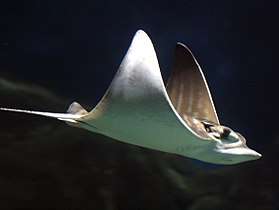Bull ray
Aetomylaeus bovinus, also known as the bull ray, is a species of large stingray of the family Myliobatidae found around the coasts of Europe and Africa.[2]
| Bull ray | |
|---|---|
 | |
| Scientific classification | |
| Kingdom: | Animalia |
| Phylum: | Chordata |
| Class: | Chondrichthyes |
| Order: | Myliobatiformes |
| Family: | Myliobatidae |
| Genus: | Aetomylaeus |
| Species: | A. bovinus |
| Binomial name | |
| Aetomylaeus bovinus (É. Geoffroy Saint-Hilaire, 1817) | |
| Synonyms | |
|
Pteromylaeus bovinus Geoffroy Saint-Hilaire, 1817 [2] | |
Biology and ecology
The species is ovoviviparous and reach sexual maturity at 4 to 6 years old. With a low fecundity of three to four pups per litter and a long gestation of 6 to 12 months (depending on the geographical zone), this species have a very sensitive life history. Very little is known concerning the ecology and behavior of Aetomylaeus b., however it is part of the coastal marine mega fauna, with a maximum length of 222 cm and 116 kg, bull rays can be considered as giants of the shallow waters. Their maximum length and very narrow depth range of 0 to 30 m exposes them to various threats. Indeed, large-body, shallow-water species are at greatest risk of threats. Bull ray appears to be extremely rare throughout the Mediterranean region and it current population trend is highly suspected to be decreasing.
This fish is named the bull ray because of the shape of its head and it is sometimes called the duckbill ray in South Africa for its long, flat, round snout.[3] Females are larger and heavier than males.
Bull rays are "bentho-pelagic" feeders, which means that they feed on the sea floor and the water column. They feed on various invertebrates including crabs, hermit crabs, squids, prawns, gastropod molluscs and bivalve molluscs.
Threats
Aetomylaeus bovinus is facing various and numerous threats, from fisheries to habitats degradation. As it is a benthic and semi-pelagic feeder, it is by-catch by a large game of industrial or artisanal fishing gears, especially pelagic trawling, bottom trawling, trammel nets, gill nets and spearfishing. Little information is available concerning this species in Africa, however old literature refers to a discard of 900 tones per year of bull rays by-caught by shrimp trawlers on the West African coast in 1988 during their late juvenile and sub/adult phase.
In the Mediterranean Sea Bull rays are considered critically endangered.
Conservation and status
On a global scale, Aetomylaeus bovinus still classified as data deficient, however in the Mediterranean Sea Bull rays have been classified as critically endanger (Cr) by the International Union for Conservation of Nature (IUCN) during the last assessment of 2015, where they were previously classified as data deficient. The Bull ray is now part of the 53% Mediterranean Sea native Elasmobranchs at risk of extinction who require urgent action to conserve their population and habitats. Bull rays appears to be extremely rare throughout the Mediterranean region and it current population trend is highly suspected to be decreasing (by 80% during the last 45years according to IUCN). There are currently no species-specific measures in place. Much research is required on the Bullray's population, size, trend, habitat, ecology, and threats. In order to protect the Bullray, its habitat needs to be protected, its harvest monitored and managed, and implementation of education and awareness programs could be beneficial.
Distribution and habitat
The full distribution of the bull ray is uncertain but it is known to be found in the Black Sea, the Mediterranean Sea, the eastern Atlantic Ocean between Portugal and Guinea, the Atlantic from north of Saldanha Bay in western South Africa and round the rest of the South African coast into the Indian Ocean up to Maputo Bay in southern Mozambique, also Zanzibar and Kenya.[3][4]
It is found between the surf zone and depths of 65 m (213 ft) or more and also enters estuaries and lagoons.[3] It frequents both the bottom and the surface and sometimes leaps from the water.[3]
The population size, trend, habitat, ecology and dynamic of the species remain unknown, however, like many members of the family "Myliobatidae" Aetomylaeus bovinus is a potential migratory species. Bull rays have been spotted in Iskenderun Bay (northeastern Mediterranean) feeding for a short period or caught on a migration corridor, moreover recent publications proved the seasonality occurrence of the species in the Adriatic Sea.
References
| Wikimedia Commons has media related to Pteromylaeus bovinus. |
- Wintner, S.P. (2006). "Pteromylaeus bovinus". IUCN Red List of Threatened Species: e.T60127A12309591. doi:10.2305/IUCN.UK.2006.RLTS.T60127A12309591.en.
- White, W.T. (2014). "A revised generic arrangement for the eagle ray family Myliobatidae, with definitions for the valid genera". Zootaxa. 3860 (2): 149–166. doi:10.11646/zootaxa.3860.2.3. PMID 25283197.
- Froese, Rainer and Pauly, Daniel, eds. (2016). "Aetomylaeus bovinus" in FishBase. January 2016 version.
- Schwartz, F.J. (2005): "Tail Spine Characteristics Of Stingrays (Order Myliobatiformes) Found In The Northeast Atlantic, Mediterranean, And Black Seas" Electronic Journal of Ichthyology, 1 (1): 1-9.
